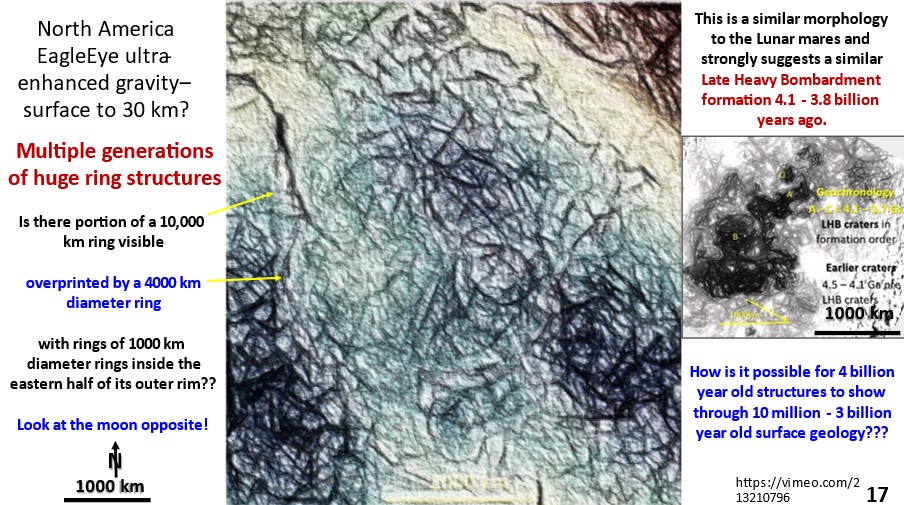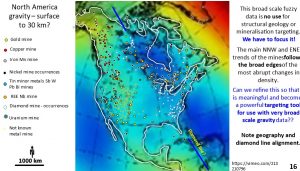
This figure shows the cut-out area of North America from the Potato Earth gravity (THE REAL SHAPE OF PLANET EARTH – 3D Animation HD https://vimeo.com/213210796). This figure shows no structural geology. We have to focus it.
However, some features can be seen. There is a linear trend to the geography shown by the blue line, which I call the Diamond Line for reasons we will later explore. The geography of the Great Slave Lake, the Great Bear Lake, the Great Lakes and Florida Peninsula lining up with the big embayment in South America suggests that there is a strong underlying linear feature.
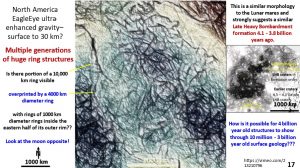
When you enhance the potato earth gravity, rings and linear structures can be seen.
There is a 3,000 km diameter concentric ring, Dakota ring, to the left of centre. In the centre of the North American continent on the Great Lakes is a very strong concentric ring structure which I have called the Lake Superior ring.
On the right lower side there is a very strong ring structure out in the Atlantic Ocean!
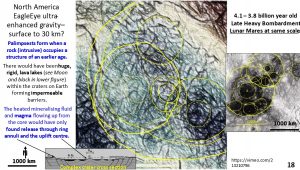
The insert on the right-hand side shows the Lunar Mares which are roughly the same scale as the smaller rings on the North American continent. They correlate in number, density and morphology (Grieve and Pilkington 1996, French 1998, French and Koeberl 2010 ).
The history of the Lunar Mares is very well known and they formed between 4.1 and 3.8 billion years ago during the Late Heavy Bombardment (LHB, Hiesinger et al., 2000 and 2010). They are the only ones that can be seen. However, there are many larger underlying rings which I see when I enhance the moon.
There were almost no impacts after 3.8 million years. The huge areas of unimpacted lava on the moon preclude large impacts after that time. Is now known that lava continued flowing on the moon right up to 1 billion years ago. The moon is a big area and if no later huge impact hit the moon then They also didn’t occur on Earth.
So, it is 100% certain that these ring structures in North America are LHB impacts and older than 3.8 billion years old. However, the North American impacts are much larger. So how can they be sitting just beneath the surface, and yet not be seen in the geography or geology of North America?
Gravity data note. Most geoscientists do not use gravity very much as it’s generally believed that gravity can only be a very general guide unless you have detailed micro gravity. We have now seen that even Earth-scale gravity, properly enhanced, can be a very powerful geological tool.
It is instructive to compare the morphology of the Lunar Mares with the huge ring structures in North America. The smaller ones in North America are the same scale as the big ones on the moon.
The centre of the ring structures on the Moon have been filled with thick lava flows, On earth they would be called large igneous provinces (LIPs).
The inset at the bottom of the image shows the morphology of a typical large complex impact structure. The centre fills with thick lava and the only place that intrusives, or mineralising fluids from beneath, can get through to the surface is on the rim or in the centre.
Thus, it is strongly suggested that the concentric ring structures in North America gravity are palimpsests (ghosts McCafferty, 1995) of the centre and rims of 4.1 to 3.8 billion year old Late Heavy Bombardment impacts.
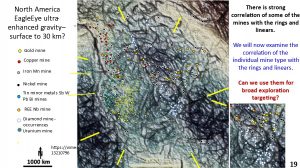
This figure shows the same concentric rings and linears in North America with the mines overlaid.
The diamond mines, in particular, follow the NNW linear and occur where this linear intersects the NW and SE of the large 3,000 km diameter ring. As there is such a strong correlation between the rings, linears and mines we can use these as an exploration targeting tool.
We will now go through the different metal commodities to observe how each metal correlates differently with the ring and linear pattern in North America.
Can we define focused exploration targets for each metal using these differences?
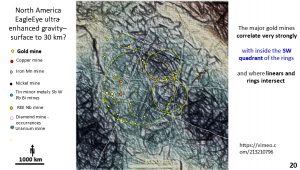
The major gold mining districts correlate very well with the large 3,000 km ring in the SW quadrant and with the south quadrant of the 1,000 km diameter ring centred on Hudson Bay in Canada.
These two major areas of gold mines are absolutely the biggest areas of gold mineralisation in North America. The SW group are the Carlin/Bingham Canyon area and the NE group is the Abitibi belt in Canada.
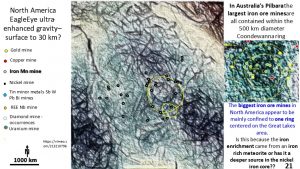
This figure shows the correlation of iron mines with the ring and linear structures in North America. The biggest iron mines in North America cluster around the Lake Superior area. This is the Lake Superior ring structure.
The same close ring association occurs in NW Western Australia. 95% of Australia’s iron comes from the Pilbara region and 95% of these are located in the 500 km diameter Coondewanna ring structure.
Has the iron enrichment come from an iron rich meteorite or has it come up from the iron nickel rich core?
As iron is a common surface mineral, I would suggest that the economic iron concentrations come from an iron rich meteorite otherwise there would be iron mines associated with many more ring structures all over the Earth.
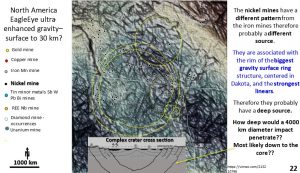
Some nickel mines are moderately associated with the large 3,000 km Dakota ring and with its intersection with the WNW linear.
Of interest is the simplified complex crater cross-section insert at the bottom of the figure.
There is speculation about how deep an impact structure would penetrate the Earth.
If the lithosphere is rigid to the core, then the impact should penetrate as a hemisphere, or deeper, and thus a 3,000 km diameter impact, like this one, should penetrate down to the Core Mantle Boundary at 2850 km depth.
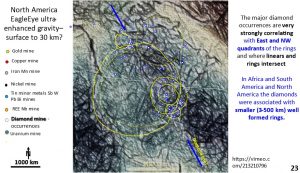
This figure shows diamond mine relationship to the gravity rings and linears.
I have found that diamond mines are very structurally controlled all over the world and North America is no exception.
Diamond mines strongly correlate with the intersection of the rings and the Diamond Line. Everywhere I have researched, the diamond mines have been associated with small rings and not large rings. This suggests that they are intimately associated with specific ring structures and not just any through-going structures that hot mineralised fluids/magmas may follow when coming up from the core.
Interestingly the diamond line has a Sinistral offset in the northern hemisphere and a Dextral offset in the southern hemisphere. This is caused by the Coriolis effect from the poles rotating fractionally faster than the equator.
The diamond mines occur in this Sinistral offset area as does the North American continent itself. Is there a relationship here?
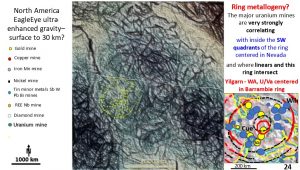
This figure shows the uranium mines in North America. At the time that I did this webinar I didn’t realise there were uranium mines up in the Athabasca Basin in Canada so unfortunately, they are not on this plan.
The uranium mines are closely associated with the Nevada ring in Arizona and we will follow this association downwards.
Uranium in Western Australia’s Yilgarn Craton Australia is also associated with just one ring. The Barrambie ring has about 80% of the uranium found in Western Australia (Watchorn, 2018. https://www.geotreks.com.au/work/giant-ring-structures/uranium-vanadium-yilgarn-barrambie-grs/). Vanadium appears to be also associated with this ring. Is there a common uranium/vanadium association worldwide?
If there was one mineral that cannot be attributed to coming up from the core it would be uranium as the Earth’s core cannot produce uranium.
However, if the Sun is a second-generation star derived from the debris of a collision of galaxies, then it and the Earth could have uranium and other heavy elements in their cores (Crosswell 2021).
Conclusions. Different mineralisation follows different structures and geomorphological features. Generally, they correlate with features one would expect for the formation of this type of mineral. Gold with rings and strong linears, diamonds with small rings and iron and uranium with discrete rings. Each of these plans can be used for exploration targeting.
Share this cutting edge geology with your colleagues!!
Happy Hunting
Bob Watchorn

